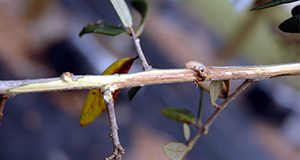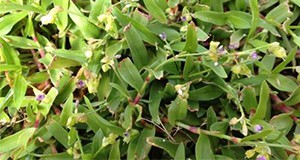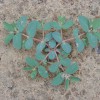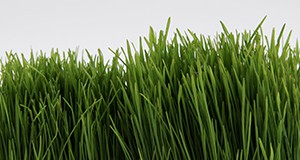
Metsulfuron-methyl, also known as MSM, is an herbicide that is used to control broadleaf weeds and certain grass weeds. It provides effective control of some of the most problematic turfgrass weeds, such as wild garlic, Florida betony, dollar weed, and small Virginia buttonweed. Metsulfuron-methyl is absorbed by plant foliage, so if landscape plants come into contact with the spray or drift they can be injured. This four-page fact sheet describes the potential problems with metsulfuron herbicides, the areas most subsceptible to damage, how to diagnose injury, and how to reduce damage. Written by Chris Marble, Jason Smith, Timothy K. Broschat, Adam Black, Ed Gilman, and Celeste White and published by the School of Forest Resources and Conservation Department.
http://edis.ifas.ufl.edu/fr400
Tag: Lawn Weeds
Turfgrass Herbicides: Mechanisms of Action and Resistance Management
Herbicides are an effective tool for controling weeds in turfgrass; however, weeds can become resistant to herbicides and create significant problems for turfgrass production. The best way to combat herbicide resistance is to rotate herbicides with different mechanisms of action (MOA) because using herbicides with different MOAs makes it more likely that weeds resistant to one herbicide will encounter an herbicide to which they are not resistant. This 4-page fact sheet focuses on how to create an herbicide program that uses different MOAs to manage resistant weeds. Written by Ramon G. Leon and Bryan Unruh, and published by the UF Department of Agronomy, August 2015.
http://edis.ifas.ufl.edu/ag398
Doveweed (Murdannia nudiflora) Control in Warm-Season Turfgrass Species
 Doveweed is an aggressive, naturalized summer annual weed that rapidly invades warm-season turfgrass species, especially in residential lawns, and few herbicides can effectively control it. Because of these challenges, a well-designed management strategy is necessary for doveweed control. This 4-page fact sheet describes identification, growth requirements, chemical control and cultural practices. Written by Ramon G. Leon and Bryan Unruh, and published by the UF Department of Agronomy, June 2015.
Doveweed is an aggressive, naturalized summer annual weed that rapidly invades warm-season turfgrass species, especially in residential lawns, and few herbicides can effectively control it. Because of these challenges, a well-designed management strategy is necessary for doveweed control. This 4-page fact sheet describes identification, growth requirements, chemical control and cultural practices. Written by Ramon G. Leon and Bryan Unruh, and published by the UF Department of Agronomy, June 2015.
http://edis.ifas.ufl.edu/ag395
Old World Diamond-Flower Biology and Management in Turf
 Old world diamond-flower is a smooth, spreading summer annual. It has branched stems with opposite, narrow leaves. Flowers are white, usually with two or more on long stalks extending from the tip of a common long stalk. Flowers occur from midsummer until frost. Reproduction occurs by seed. Found in moist areas, especially areas that have been disturbed. This 2-page fact sheet was written by Darcy E. P. Telenko, Barry J. Brecke, Ramon Leon, and J. Bryan Unruh, and published by the UF Department of Environmental Horticulture, December 2013.
Old world diamond-flower is a smooth, spreading summer annual. It has branched stems with opposite, narrow leaves. Flowers are white, usually with two or more on long stalks extending from the tip of a common long stalk. Flowers occur from midsummer until frost. Reproduction occurs by seed. Found in moist areas, especially areas that have been disturbed. This 2-page fact sheet was written by Darcy E. P. Telenko, Barry J. Brecke, Ramon Leon, and J. Bryan Unruh, and published by the UF Department of Environmental Horticulture, December 2013.
http://edis.ifas.ufl.edu/ep493
Erect and Prostrate Spurge Biology and Management in Turf
 Erect and prostrate spurges are erect or upright annuals with branched stems. Leaves are opposite and not equal. Stems produce “milky sap.” A large number of spurge species occur in Florida. Reproduction occurs via seed. This 2-page fact sheet was written by J. Bryan Unruh, Darcy E. P. Telenko, Barry J. Brecke, and Ramon Leon, and published by the UF Department of Environmental Horticulture, December 2013.
Erect and prostrate spurges are erect or upright annuals with branched stems. Leaves are opposite and not equal. Stems produce “milky sap.” A large number of spurge species occur in Florida. Reproduction occurs via seed. This 2-page fact sheet was written by J. Bryan Unruh, Darcy E. P. Telenko, Barry J. Brecke, and Ramon Leon, and published by the UF Department of Environmental Horticulture, December 2013.
http://edis.ifas.ufl.edu/ep495
Weed Management Guide for Florida Lawns
 Weeds can be defined as unwanted plants or plants growing out of place. Proper identification and some understanding of how and why weeds are present in a lawn are important when selecting the best control strategy. Knowing whether or not weeds were previously present in a particular area also helps homeowners prepare control measures in the future. Weed control should be a carefully planned and coordinated program. This 8-page fact sheet was written by J.Bryan Unruh, Ramon G. Leon, Barry J. Brecke, and Laurie E. Trenholm, and published by the UF Department of Environmental Horticulture, July 2013.
Weeds can be defined as unwanted plants or plants growing out of place. Proper identification and some understanding of how and why weeds are present in a lawn are important when selecting the best control strategy. Knowing whether or not weeds were previously present in a particular area also helps homeowners prepare control measures in the future. Weed control should be a carefully planned and coordinated program. This 8-page fact sheet was written by J.Bryan Unruh, Ramon G. Leon, Barry J. Brecke, and Laurie E. Trenholm, and published by the UF Department of Environmental Horticulture, July 2013.
http://edis.ifas.ufl.edu/ep141
HS1177 Homeowner Considerations Prior to Selecting a Weed Control Product
HS1177, a 3-page fact sheet by Andrew W. MacRae and Marina D’Abreau, coaches homeowners to consider weed type and location in the landscape in selecting a herbicide as part of an effective weed management program. Published by the UF Department of Horticultural Sciences, May 2010.
http://edis.ifas.ufl.edu/hs1177
HS1170 Nonchemical Weed Control for Home Landscapes and Gardens
HS1170, a 3-page fact sheet by Andrew MacRae and Marina D’Abreau, lists some of the most common options for nonchemical weed control and descriptions of their pros and cons. Published by the UF Department of Horticultural Sciences, April 2010.
http://edis.ifas.ufl.edu/hs1170
Weed Biology and Management in Turf series
This series of 1-2 page illustrated fact sheets by J. Bryan Unruh, Darcy E. Partridge-Telenko, and Barry J. Brecke highlight key facts about each weed, and include herbicide options for each variety of Florida turfgrass. Published by the UF Department of Environmental Horticulture, June 2009.
- ENH1124/EP385 Yellow Woodsorrel (Oxalis) Biology and Management in Turf
- ENH1125/EP386 Virginia Buttonweed Biology and Management in Turf
- ENH1126/EP387 Torpedograss Biology and Management in Turf
- ENH1127/EP388 Florida Betony Biology and Management in Turf
- ENH1128/EP389 Pennywort (Dollarweed) Biology and Management
- ENH1131/EP392 Annual Bluegrass Biology and Management in Turf
- ENH1132/EP393 Tropical Signalgrass Biology and Management in Turf
- ENH1133/EP394 Goosegrass Biology and Management in Turf
- ENH1134/EP395 Crabgrass Biology and Management in Turf
http://edis.ifas.ufl.edu/TOPIC_SERIES_Weed_Biology_and_Management_in_Turf
ENH884/EP141 Weed Management in Home Lawns
Revised! ENH-884, a 9-page fact sheet by J.Bryan Unruh, Barry Brecke, Laurie E. Trenholm, provides homeowners with information to carry out a carefully planned and coordinated weed control program for their lawns. Describes types of weeds, proper lawn management, weed biology and control, weed control prior to turf establishment and in established turf, and pesticide application procedures. Published by the UF Department of Environmental Horticulture, April 2008.
